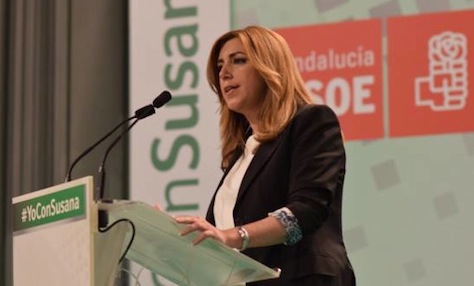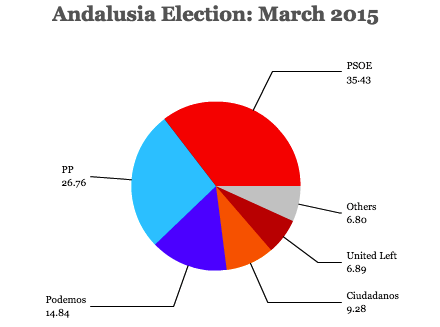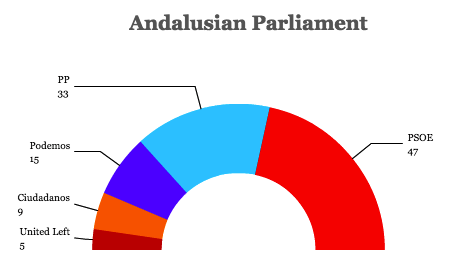After last Saturday’s election, it’s no exaggeration to say that Andalusia’s regional president Susana Díaz might be the most popular politician in Spain.![]()
![]()
Díaz, who heads the Partido Socialista Obrero Español (PSOE, Spanish Socialist Worker’s Party) in Andalusia, the largest region — or ‘autonomous community’ — in Spain, won her first term as regional president since taking power in 2013 upon the abrupt resignation of her predecessor, José Antonio Griñán. Both Griñán and Manuel Chaves, who governed the region between 1990 and 2009, are under investigation for their connection to a wide-ranging ‘ERE’ corruption scandal involving the diversion of funds designated to assist laid-off workers in Andalusia, where the unemployment rate remains stubbornly high at 34%, the worst in Spain, where joblessness also remains stubbornly high, despite its economy’s tepid 1.4% growth last year — the first year of GDP expansion since 2008.
Those two concerns, jobs and corruption, dominated the campaign in Andalusia, the sprawling southern region of Spain.
* * * * *
RELATED: In Andalusia, Díaz takes office with staggeringly high unemployment, economic woes (September 2013)
* * * * *
Though Andalusia has been a Socialist stronghold since the return of democracy in the late 1970s, disillusionment with widespread corruption and with Spain’s deteriorating economy gave the center-right Partido Popular (PP, People’s Party) of prime minister Mariano Rajoy its first Andalusian electoral victory in March 2012. Despite the Socialists’ losses, the party remained in power by forming a coalition with a smaller left-wing coalition of parties, Izquierda Unida (IU, United Left).
The Socialist-IU coalition continued under Díaz, who at age 40 is pregnant with her first child and who still marks a sharp contrast, generational and otherwise, with the region’s previous Socialist leaders. Díaz, a sharp-tongued populist who declined to contest the party’s national leadership, has also declined (so far) to challenge the PSOE’s leader Pedro Sánchez to become the prime ministerial nominee in November’s general elections.
Her victory in Andalusia’s March 22 snap election, called in January after Díaz wearied of the IU’s demands as junior coalition partner, will give hope to Sánchez and the national PSOE leadership that it can thrive throughout the 2015 electoral gauntlet.
An additional 13 regions will hold elections on May 31, including Madrid, the Valencian Community and Castile and León, the third, fourth and sixth most populous regions in Spain, respectively. Rajoy’s PP and its allies are defending governments in 11 of the 13 regions, including each of Madrid, Valencia and Castile and León. The party’s 17-seat loss in Andalucia, therefore, is an alarming sign for the ruling party.
In Catalunya, where separatists last year tried to hold a referendum on independence, center-right regional president Artur Mas has called early regional elections for September 25 and he’s cast the vote as yet another chance for Catalans to embrace independence.
Rajoy and the Popular Party will face voters no later than November, with polls showing that the electorate’s support is split among four parties — the traditional center-right (PP) and center-left (PSOE) parties, as well as the leftist, anti-austerity Podemos, founded in January 2014, and Ciudadanos (C’s, Citizens), a centrist, liberal party with origins as a federalist movement in Catalunya that is now contesting elections nationally. If the chief story of Spanish politics in 2014 was the rise of Podemos, which now narrowly leads most polls nationally, the chief story of the first three months of Spanish politics in 2015 has been the more implausible rise of Ciudadanos, which is increasingly locked in a four-way free-for-all with the other parties.
While both Podemos and Ciudadanos thrived in Andalusia’s elections, neither came close to challenging the PSOE’s hegemony, which makes the March 22 vote a poor indicator of national trends. For all the discussion that the new parties, and Podemos in particular, are upending Spanish politics, it’s not clear that voters in nine months’ time will be willing to entrust government to an untested party with only a vague anti-austerity agenda — especially if Greek prime minister Alexis Tsipras, who won election in January on a sharp, anti-austerity platform, struggles in his attempts to redefine Greece’s relationship with European leaders and lenders.
Podemos, nevertheless, will take some comfort that it emerged as the third force of Andalusian politics, easily displacing the United Left coalition, which lost all but five of its seats in the 109-member regional parliament. Competing in just its first non-Catalan regional election, Ciudadanos will also delight in its result. Together, they won enough seats to deprive Díaz of an absolute majority, forcing her next government to negotiate with Spain’s two newest political movements to pass legislation. Despite tough talk, Díaz has not yet delivered on either reforms to reduce regional corruption or enacting a massive economic turnaround, and there’s some doubt that Díaz even has the power to effectively steer economic policy when Madrid and Brussels have much more control over fiscal and monetary policy. Voters, however, were willing to give Díaz the benefit of the doubt.
Moreover, if Spain’s economic bounceback continues in 2015 and 2016, Díaz could be in a strong position to win the PSOE leadership and, possibly, the national premiership if Sánchez stumbles in this year’s general election. She wouldn’t be the first Andalusian to do so. Felipe González, Spain’s Seville-born Socialist prime minister from 1982 to 1996, effectively transitioned Spain from the end of Francoist rule to democracy and ushered the country into the European Union — and delivered a hefty amount of European aid to his native Andalusian.


